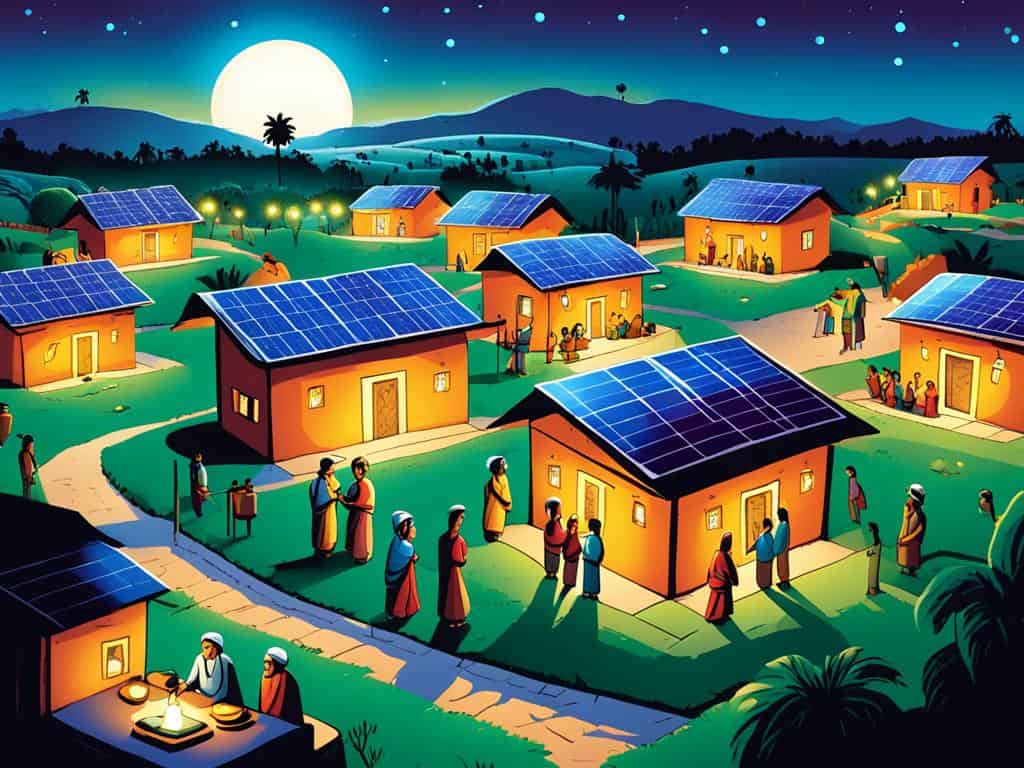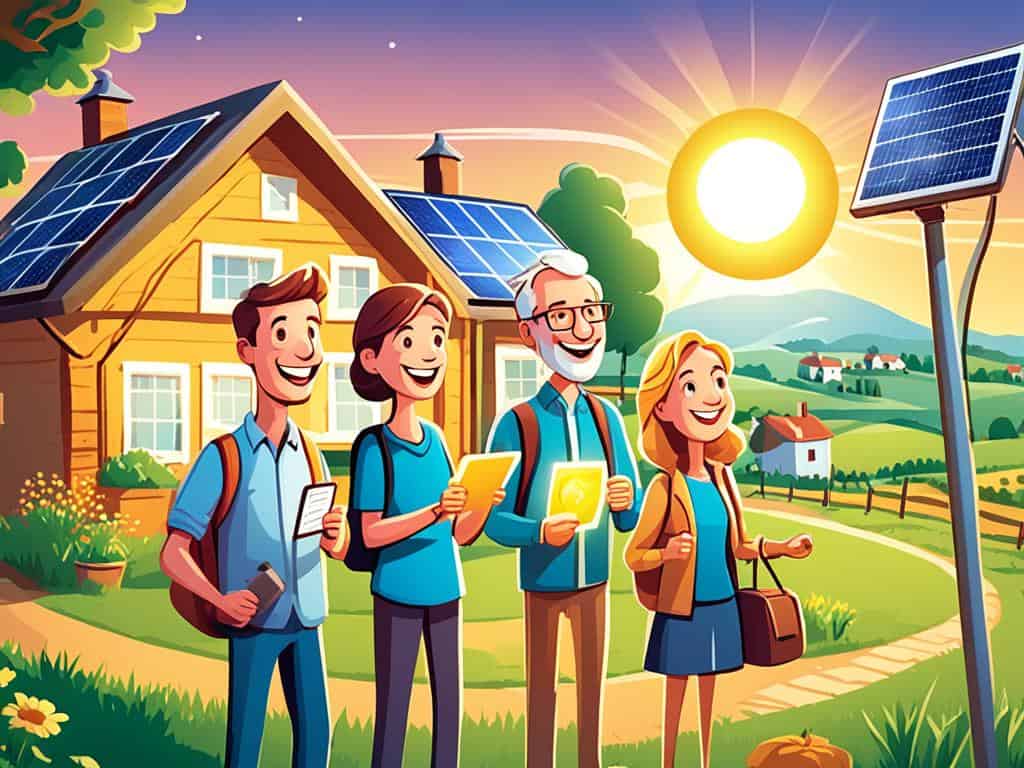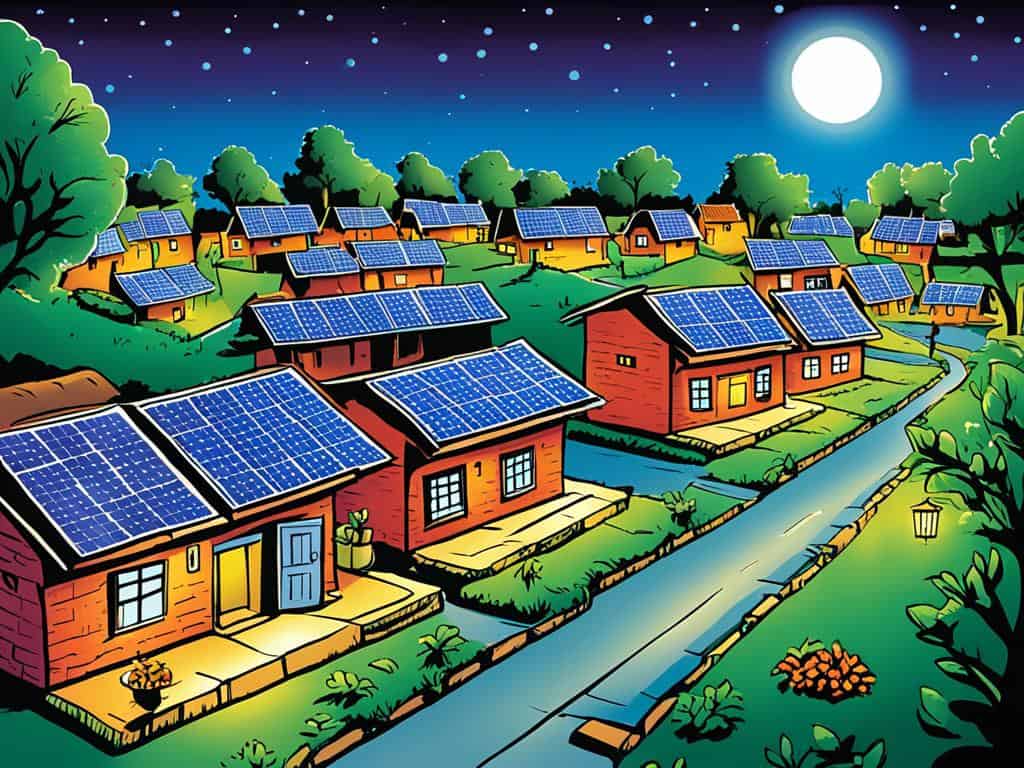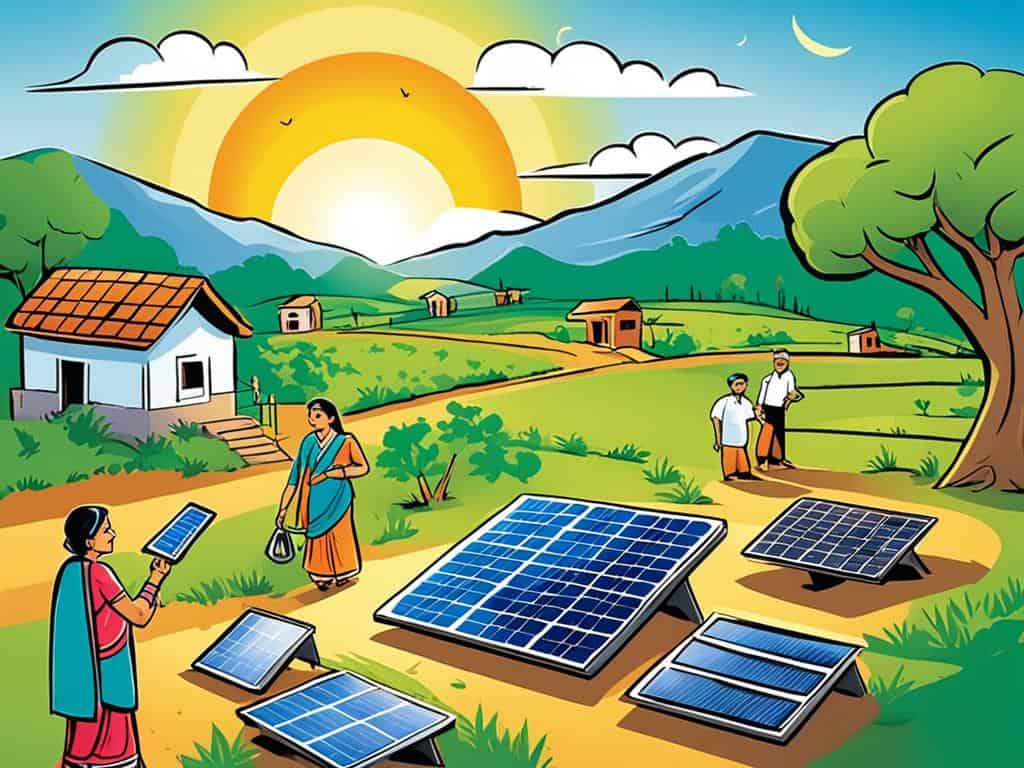How Solar Lamps Are Lighting Up Indian Villages: Benefits and Installation Tips
Discover how solar lamps are revolutionizing illumination in Indian villages with easy installation tips and the perks of sustainable lighting.

Imagine when the sunset brings darkness inside homes as well as outside. Now, think about a simple solar lamp breaking through this gloom. It turns nights into times of chance. This change is happening in many Indian villages. Here, solar lamps are more than sustainable lighting solutions. They stand for growth and independence.
Fenice Energy sees the sunlight’s role in bettering lives. They aim to bring light to rural India’s darker areas. By providing clean energy solutions, Fenice Energy doesn’t just light up homes. They also fuel dreams by allowing education, longer working hours, and a safer community. With the right knowledge and installation tips, the sun has become a dependable friend for many.
But, brightening a home without electric grid access involves more than you might think. It’s about empowerment, learning new skills, and changing communities for the better.
Key Takeaways
- The profound impact of solar lamps on the socio-economic landscape of rural India.
- How sustainable solar energy solutions can lead to self-sufficiency and safety in off-grid areas.
- A spotlight on the Barefoot College initiative and its role in educating women as solar engineers.
- Fenice Energy’s dedication to offering clean energy solutions tailored to the unique needs of Indian villages.
- Essential insights and practical tips for installing and maintaining solar powered systems.
The Illuminating Power of Solar Lamps in Rural India
In rural India, things are getting brighter. Solar powered lights are bringing hope and light where there was once darkness. These aren’t just lights; they’re stepping stones towards progress and independence in areas without reliable electricity.
The demand for solar lighting in Indian villages is growing fast. By 2029, it’s expected to reach INR 48,533 million. This growth, fueled by a 16.8% increase each year, highlights the vital role of hardware like solar panels, batteries, and light fixtures in these systems. They show how far sustainable lighting solutions have come and their potential to grow.
The push for solar lights is driven by growth in renewable energy and better infrastructure. But, moving forward has its own set of problems. High setup costs and dependence on old power sources are big hurdles. We need smart policies and support from leading companies to overcome these challenges.
Sustainable lighting solutions have really changed rural areas. Women, who were often denied education, are now leading the change as ‘Solar Mamas’. They’re installing solar systems and fighting illiteracy and poverty by learning new skills at places like Barefoot College International.
Fenice Energy has been a big player in clean energy for twenty years. They know how much solar powered lights can change lives. By working with communities and embracing new technologies, they’re helping to illuminate rural India.
LED technology is making solar lights even better. Partnerships like Wipro Lighting and Enlighted are essential. They’re working together to bring reliable, efficient lighting to every rural corner of India.
To sum it up, solar lamps are a symbol of hope in rural India. There are still obstacles, but the combined efforts of the government, companies like Fenice Energy, and local communities are lighting the way forward. Thanks to these efforts, homes can glow with brightness even after the sun sets.
The Economic Advantages of Solar Powered Lights in Village Settings

Bringing solar powered lights to Indian villages has changed the rural economy. This change brings lots of economic advantages. Fenice Energy noticed the impact on village life. This is especially true for small-scale businesses and local jobs.
Stimulating Small-scale Businesses
In places relying on old energy sources, solar lights signal progress. For example, rural India makes up about 69 percent of the population. Nearly 300 million people there use old energy sources, like kerosene. Switching to solar energy helps these people a lot. It gives them clean water and cheap electricity.
This change helps businesses stay open longer. It boosts the economy and helps women start their own businesses. Also, solar energy can improve schools in these areas. It supports learning new skills and starting businesses. It also helps with health, education, and communication. India wants to make 500 GW of solar power by 2030. This goal supports business growth and new ideas.
Job Creation and Property Value Enhancement
Setting up solar power creates jobs. India has more solar power now, thanks to big projects in Rajasthan and Karnataka. These projects need many skilled workers. Entrepreneurs are getting into the solar business too. They follow rules to get benefits from India’s solar plan.
Renewable energy is good for the planet and property values. Solar lights make places safer. This attracts investors. From big projects like the Bhadla Solar Park to small solar grids, solar power is raising property values in villages.
Exploring the Cost-Effectiveness and Durability of Solar Lamp Solutions
In rural India, the push for cost-effectiveness and durability in solar lamp solutions is crucial. This region is making strides in renewable energy, shifting towards energy-efficient lighting. Solar technologies are becoming popular because of this.
Solar lamp solutions mark a big change from old lighting types. They last longer and don’t need to be replaced as often. They are cheaper to run than traditional lights, making them both budget-friendly and good for the planet.
Fenice Energy provides strong solar lamp solutions. These products save money and last a long time. They are especially useful in rural areas where reliable electricity is hard to come by.
| Feature | Impact |
|---|---|
| Generation Capacity | Solar lamps: 1-1.5 Wp Solar home systems: 20-100 Wp |
| Adoption Factors | Awareness, available electricity during dark hours, and motivation to adopt technology |
| Material Efficiency | Thin film solar cells use fewer raw materials, reducing costs and resource consumption |
| Technological Innovation | Quantum dots and nanowires enhance light absorption and energy conversion |
Rural homes might not know about solar power benefits. Fenice Energy is working to fix this through awareness campaigns. They show how solar lamp solutions can be a big help, especially where there’s no reliable electricity.
The latest solar cell technology makes solar units lighter and cheaper. This progress means energy security might soon be achievable for rural India.
The success of the Million Solar Urja Lamp Program by IIT Bombay shows the value of solar power. It highlights how affordable and accessible solar technology can improve lives.
India is nearing universal electricity access, but solar offers a unique opportunity. It’s a way to power homes that’s both affordable and long-lasting. Solar is key for a future with economic and environmental resilience.
The Role of Outdoor Solar Lighting in Enhancing Village Safety and Security
As night falls, rural areas face significant safety and security risks due to poor lighting. Outdoor solar lighting offers a beacon of hope, improving these conditions. Fenice Energy specializes in clean energy solutions. They link better lighting to safer villages, with solar lights playing a key role.

Reduced Risks of Nighttime Accidents and Wildlife Encounters
Darkness hides many dangers, from tripping hazards to wildlife threats. Outdoor solar lighting reduces these risks. Well-lit areas provide safety, allowing people to move freely at night.
Improved Visibility for Villagers’ Nightly Activities
Better lighting enhances safety and makes night tasks easier. It allows villagers to visit wells or gather without fear. This boost in infrastructure improves life and safety in villages.
| Feature | Benefit | Specifics |
|---|---|---|
| Charge Controller Circuit | Optimization of Charging | Prevents overcharging with a voltage divider that converts 12v to 5v |
| Load Intensity Control | Energy Conservation | ArduinoUNO software manages PWM for varying light intensity |
| LED Street Lights | Enhanced Longevity and Lower Consumption | Popular choice for their efficiency and lifespan |
| Solar Panel Technology | Rural Electrification | Harnesses sunlight, converting it into electricity for village safety |
| Material Quality | Durability and Weather Resistance | Use of high-purity aluminum and Q235 steel for long-lasting structures |
| Intelligent Design | Improved Visibility and Aesthetics | Considers factors like color temperature, illuminance, and pole spacing for optimal lighting |
Solar lighting tech from the Indus Institute of Engineering and Technology brings light to villages. It enhances safety and security sustainably. Fenice Energy leads in crafting these vital outdoor solar lighting solutions.
Environmental Impacts: Solar Garden Lights as a Clean Energy Champion
Solar garden lights shine as a key to clean energy, reflecting an urgent need. They offer a greener way to light up outside spaces. This aligns with goals for a healthier planet. Fenice Energy leads in promoting these clean alternatives.
The last decade showed progress in electricity access worldwide. Yet, about 660 million may still lack it by 2030, especially in Africa. Solar lights can help bridge this gap. They also reduce dependence on harmful cooking methods used by many.
In 2020, only about 19.1% of the world’s energy was green. A significant part of this was from burning wood, which isn’t ideal. Solar lights avoid this pitfall. They provide clean light, helping to keep the air clean in remote areas.
India aims for a big shift towards clean energy by 2030. They’re focusing on non-fossil fuel sources and leading in green hydrogen. Fenice Energy supports this with innovative technologies. They believe in solar to handle growing energy needs without harming the planet.
Solar garden lights are a part of this clean future. They reduce CO2 and are easy on the environment. Renovagen’s Rapid Roll system shows how solar solutions can reach isolated places. Fenice Energy is committed to such eco-friendly solutions.
Looking ahead, India and groups like Fenice Energy dream of a solar-powered home for everyone. Solar lights do more than light up yards. They show the way to a future with less pollution and more clean energy.
Maintenance Ease with Standalone Solar Light Fixtures
India’s solar lighting market is growing fast, expected to reach INR 650.44 million by 2029. Fenice Energy leads by offering easy-to-maintain standalone solar light fixtures. These make solar solutions more appealing, especially where easy upkeep is vital.
Fenice Energy focuses on making installation easy. What used to need a lot of hardware is now simple. By using solar panels, batteries, and LED lights, installations have become straightforward. This makes energy-efficient lighting easier to access than before.
Simplification of Installation
Standalone solar lights have simplified what used to be complex. Fenice Energy, a leading company, has made installation effortless. There’s no complicated wiring or need for continuous electricity. This ease of installation supports India’s renewable energy growth.
Minimized Technical Upkeep
Technical care for these solar fixtures is no longer a big worry. They are made to last and work on their own. Thanks to their design, there’s hardly any maintenance needed. Fenice Energy has made these systems dependable, even in remote areas.
India is one of the top users of electricity globally. It’s moving towards more off-grid and hybrid solar solutions. Fenice Energy combines innovation with easy maintenance. Their standalone solar lights offer a reliable option beyond traditional power sources. These fixtures provide steady light without needing much upkeep, brightening India’s future infrastructure.
Challenges in Adoption: Overcoming Hurdles with Solar Lighting Technology
The journey of bringing solar lighting to India’s landscape has its challenges in adoption. Initial issues like inefficient solar cells and high setup costs are big obstacles. Solar lamps promise a brighter future for places like rural streets and community spaces. But, their need for consistent sunlight is a challenge in less sunny areas.
Transitioning to solar energy involves overcoming technical and financial hindrances. This includes the need for big energy storage solutions. Environmental and institutional roadblocks also slow progress, as the costs now versus sustainability later are weighed. Despite their popularity in cities, solar lamps struggle in rural areas due to costs and infrastructure.
According to Fenice Energy, “Empowering communities with solar lighting technology lights up their streets and builds safety and community. But, it’s vital to overcome funding and resource hurdles for adoption.”
- Intermittency issues affect power grid stability
- Technical barriers with existing infrastructure
- Challenges in accurately measuring solar radiation
- Political dynamics influencing solar policy
| Challenge | Impact | Solution |
|---|---|---|
| High Initial Costs | Deters upfront investment in solar technology | Government subsidies and low-interest loans |
| Technical Barriers | Needs expertise for installation and maintenance | Training programs and user-friendly systems |
| Space Requirements | Limits large scale use in small areas | Compact design solutions |
| Inadequate Skilled Manpower | Delays deployment and support | Partnerships for educational skill programs |
Fenice Energy believes solar lamps could be key to educations in rural areas. But, they must stay bright in all weathers and be cost-effective compared to traditional lights. Fenice suggests blending technological strides in solar with affordable finance models.
The “Solar Power in Your Community” guidebook supports India’s solar goal. Along with advice, it stresses fair solar development. It suggests forming advisory committees from various groups to support solar initiatives.
Fenice Energy talks about setting local solar installation goals. These should consider local limits and community benefits. Tools like DeepSolar and Project Sunroof provide important data for realistic and impactful goals.
Overcoming solar technology’s adoption hurdles needs efforts from everyone. From homeowners to policymakers, consistent, informed action is key. This way, solar energy can be a clean, sustainable lighting solution for all of India.
Government Incentives and Awareness Programs for Eco-friendly Outdoor Lighting
India is moving towards a more sustainable future. Government incentives and awareness programs play a key role in this. They help make eco-friendly outdoor lighting, like solar lights, both affordable and easy to get for everyone.

The government knows how artificial lighting affects our environment. They also see the value of renewable energy. That’s why they offer financial help and reduce barriers for getting solar lights. This, along with education efforts, is changing how communities think about lighting solutions.
Subsidization and Financial Assistance
Fenice Energy highlights the benefits of Production Linked Incentive (PLI) Schemes. These schemes are aimed at boosting investments in several areas, including green outdoor lighting. With a budget of INR 1.97 Lakh Crores, they’ve accepted 733 applications. This is expected to significantly boost the economy and create lots of jobs, especially in small businesses.
The automobile and ACC Battery Storage sectors are great examples. They plan to invest INR 67,690 Cr and INR 18,100 Cr, respectively. This shows India’s big commitment to eco-friendly production and energy solutions.
Educational Initiatives to Promote Solar Usage
The government is also working to educate people about solar energy benefits. Fenice Energy supports this by backing regional education programs. One is the World Resources Institute’s webinars, focusing on fair energy policies. Another is the Sierra Club’s guidelines, helping to shift towards 100% renewable energy, like solar.
All these efforts from the government and private sectors aim to build a strong foundation. They want to make eco-friendly outdoor lighting common across India. This will not only light up our streets. It will also help our communities grow in a sustainable way. Plus, it’s good for our planet.
Installation Tips for Achieving Optimal Efficiency in Solar Lighting
To make sure solar lighting systems work well, installing them correctly is key. At the front of eco-friendly lighting, Fenice Energy highlights the need for smart setup. These tips not only improve solar lamp performance but also help them last longer.
Assessing the Proper Angles and Directions
Solar panels need the right angle and direction to catch the most sun. This means knowing the area’s geography and tilting the panels to match the local latitude. They should also stay clear of any shade from trees or buildings for the best sunlight all day. Fenice Energy knows how important this is, especially in Indian villages using solar power at night.
Ensuring Maximum Sunlight Exposure
Putting solar lamps in sunny spots is crucial. They work best with direct sunlight from morning to evening. So, placing panels to face south in many parts of India is smart. This ensures nothing blocks the sunlight. Fenice Energy suggests closely inspecting the area to find the sunniest spot when setting up solar lighting in Indian villages.
| Benefit | Impact | Importance |
|---|---|---|
| Energy Efficiency | Operate independently of the grid | Minimize energy consumption and reduce reliance on non-renewable resources. |
| Cost Savings | No electricity bills | Lower operational costs than traditional lights; reduces maintenance needs. |
| Environmental Impact | Reduction in carbon emissions | Contributes to climate change mitigation and advances sustainable development. |
| Public Safety | Well-illuminated streets | Reduces the risk of accidents, deters crime, and increases visibility for all. |
| Power Outage Resilience | Independent energy storage | Stores excess energy for uninterrupted lighting, countering power outages. |
| Rural Development | Improves infrastructure | Enhances quality of life, security, and economic activities in rural areas. |
| Urban Beautification | Aesthetic enhancement of urban areas | Promotes a sense of pride among residents and elevates communal spaces. |
| Sustainable Tourism | Solar schemes in tourist spots | Improves safety and underscores commitment to eco-friendly practices. |
| Collaborative Partnerships | Effective implementation | Optimizes resource allocation through governmental and private collaboration. |
| Education & Awareness | Programs to inform citizens | Increases knowledge regarding solar lighting maintenance and benefits. |
| Policy Support | Incentives for adoption | Encourages wider adoption through financial subsidies and tax benefits. |
Using these tips has many benefits. They lead to less use of non-renewable resources and lower costs. They also improve safety, support rural areas, ensure light during power cuts, and promote eco-friendly tourism. With wise policies and teamwork, solar lighting’s future is promising. Fenice Energy is dedicated to leading the way with skill and know-how.
Conclusion
Solar lamp technology is changing Indian villages for the better. It’s making energy use efficient and eco-friendly. By using solar lamps, villages see more economic growth and feel safer at night. Fenice Energy is leading this change by offering clean energy. This helps cut electricity costs and builds a strong, independent future for these areas.
Fenice Energy’s solar lighting systems show their value by being eco-friendly and saving money. They use sunlight for power, giving long-lasting light without much upkeep. These systems do not need the grid to work. They are becoming affordable and popular for rural areas because they don’t harm the environment and save resources.
Solar lamps are key for sustainable living in Indian villages. They are a smart choice that pays off quickly and keeps the future bright. With government support and growing public awareness, solar lights are becoming a staple in rural areas. This move, driven by Fenice Energy’s experience, means better lives, more opportunities, and protecting the environment.
FAQ
How are solar lamps transforming Indian villages?
Solar lamps provide reliable and affordable light in Indian villages. They are eco-friendly, supporting extended work hours, more learning time, and safety at night. This change is making life better for the residents.
What are the economic advantages of solar powered lights in villages?
Solar lights lead to more business income by allowing longer work hours. They create jobs and increase property values. Also, they lower electricity costs and need less upkeep, saving money for villagers.
How do outdoor solar lighting systems enhance village safety and security?
Outdoor solar lights keep away animals and intruders, making villages safer. They prevent accidents in the dark. People can safely go about at night and travel between places.
What makes solar garden lights a champion for clean energy?
Solar garden lights run on renewable energy, cutting down on fossil fuel use. They keep the air clean and add beauty without harming the planet. This supports a sustainable and clean earth goal.
Are standalone solar light fixtures easy to maintain?
Yes, standalone solar lights are simple to set up with no complex wires. They work on their own and need little care, perfect for distant villages. These lights are a good solution for lighting needs.
What challenges do villages face in adopting solar lighting technology?
Villages struggle with understanding solar light benefits and the high setup cost. Teaching people and offering money help can ease these issues, leading to more solar light use.
How does the government support the adoption of eco-friendly outdoor lighting?
The Indian government helps by giving money aid and teaching about solar lights. It is working to make these green lights cheaper, pushing villagers towards a sustainable choice.
What installation tips can maximize the efficiency of solar lighting?
For best performance, place solar lamps where they get the most sun. Make sure solar panels face the sun for enough energy all day. This ensures bright light throughout the night.


